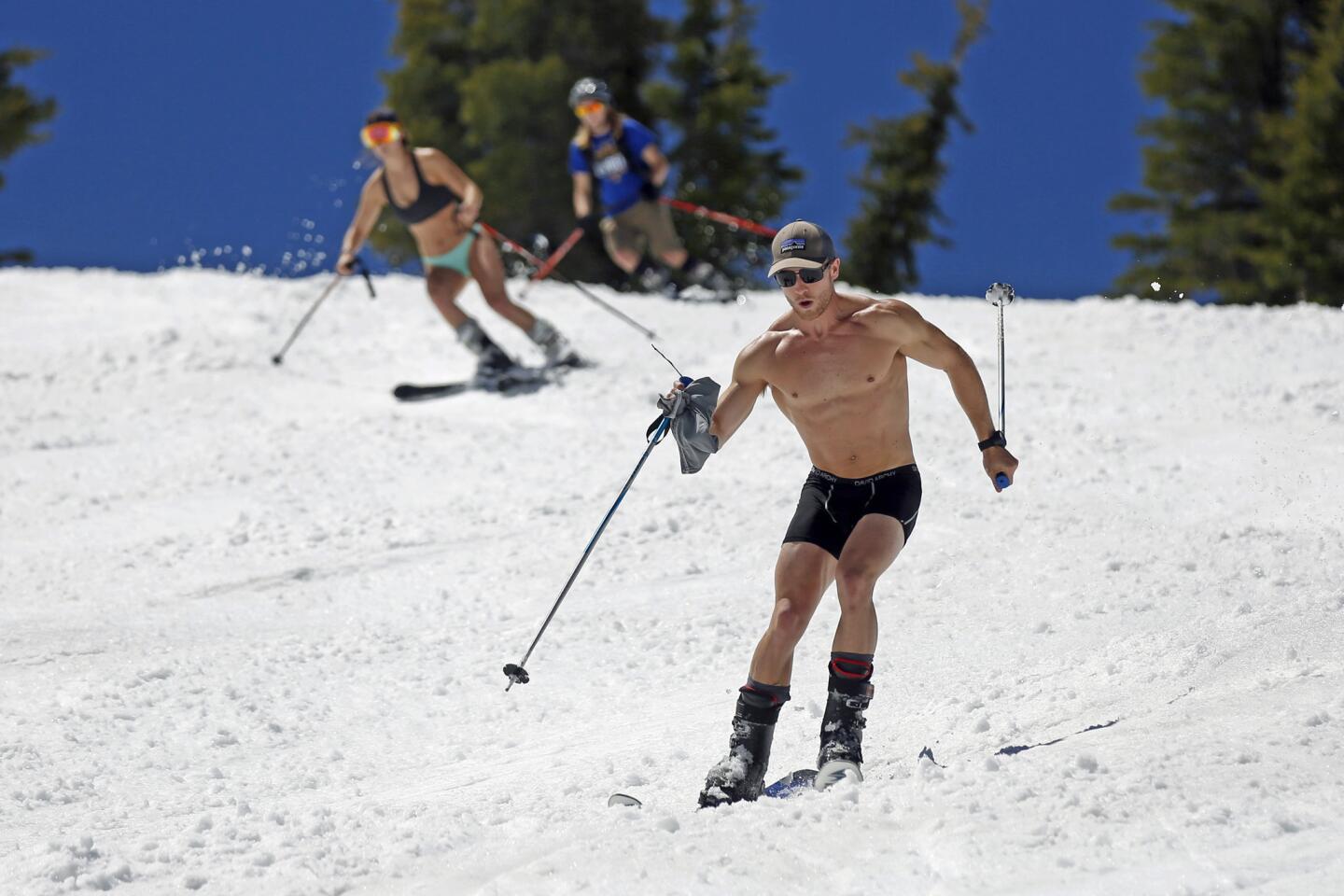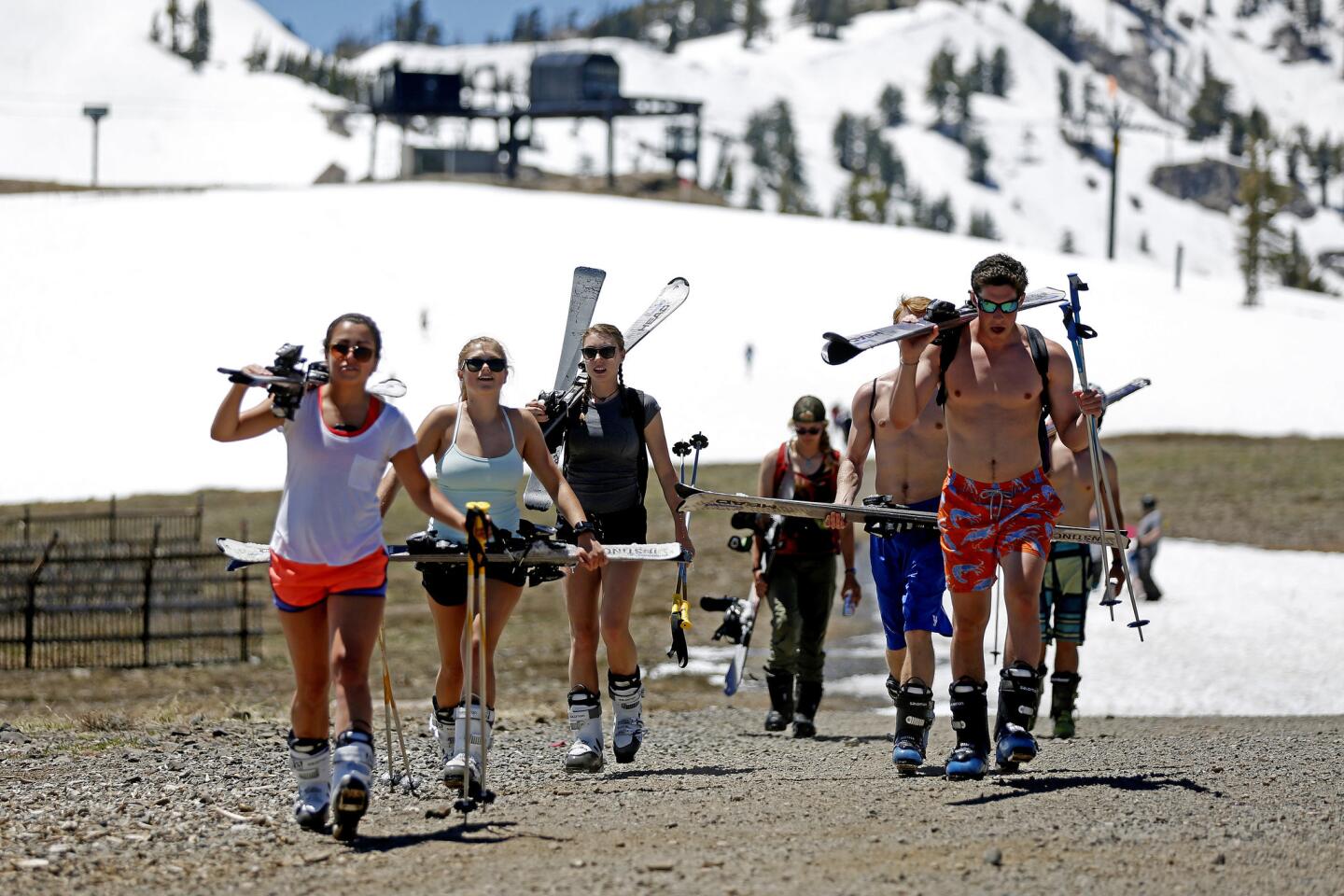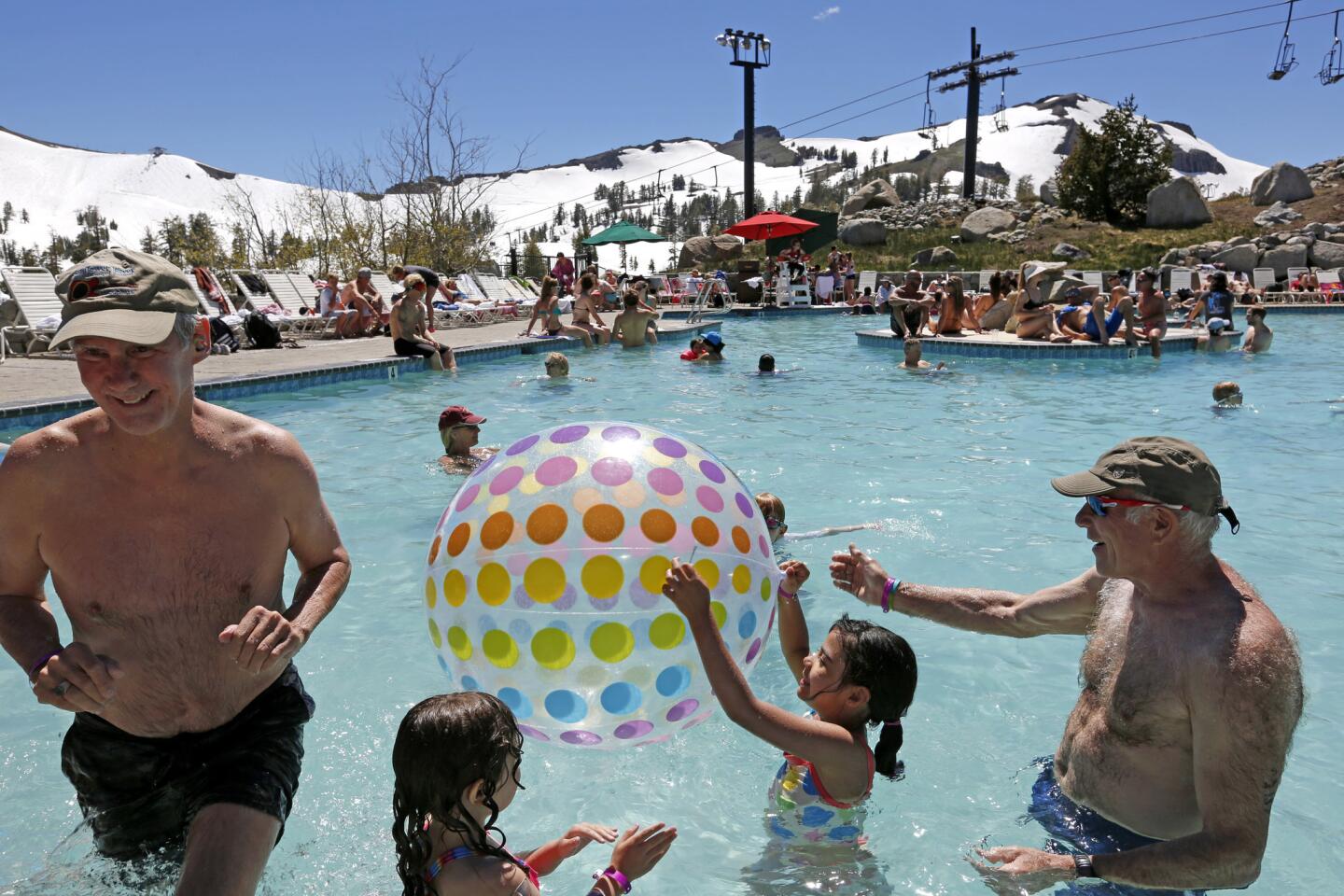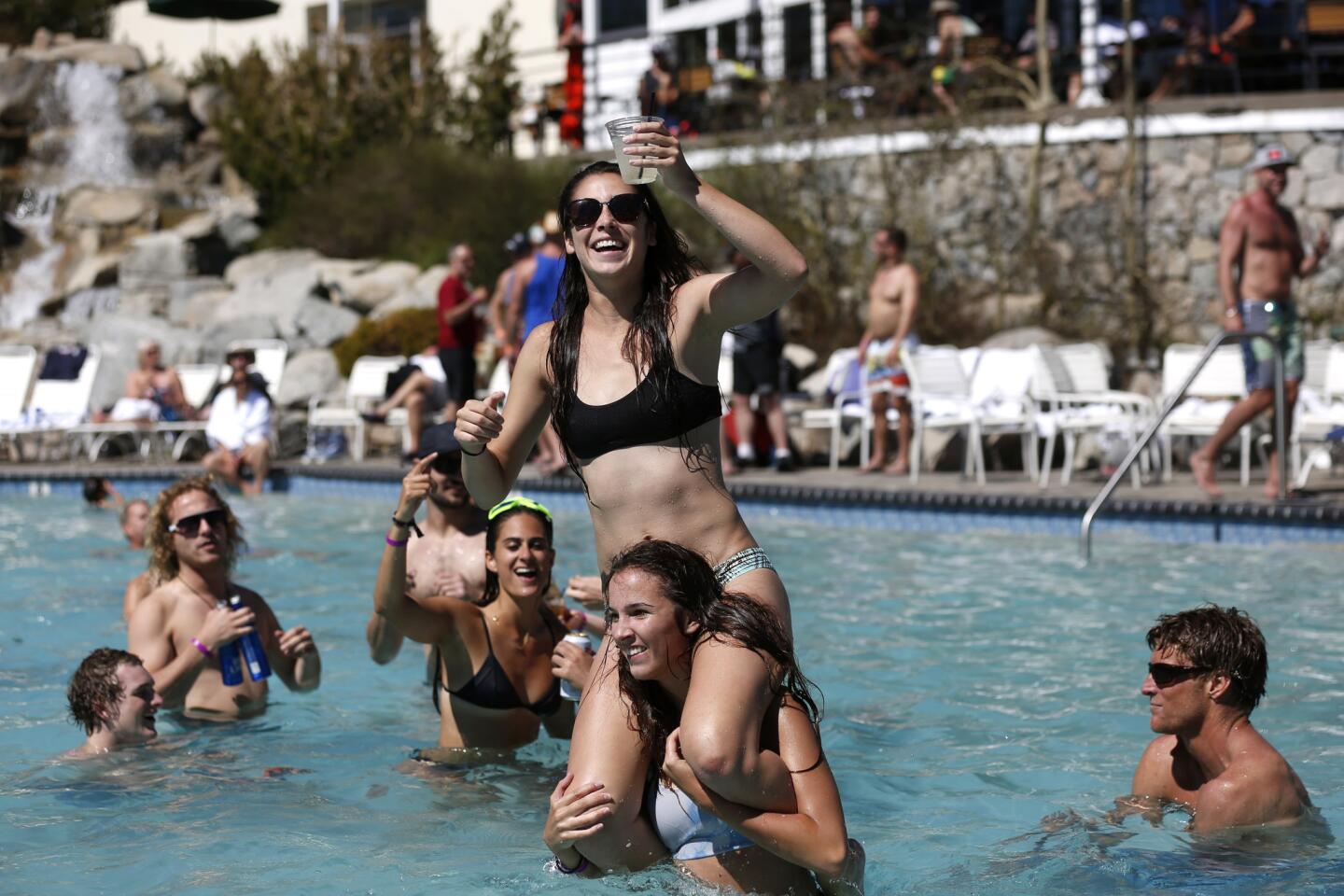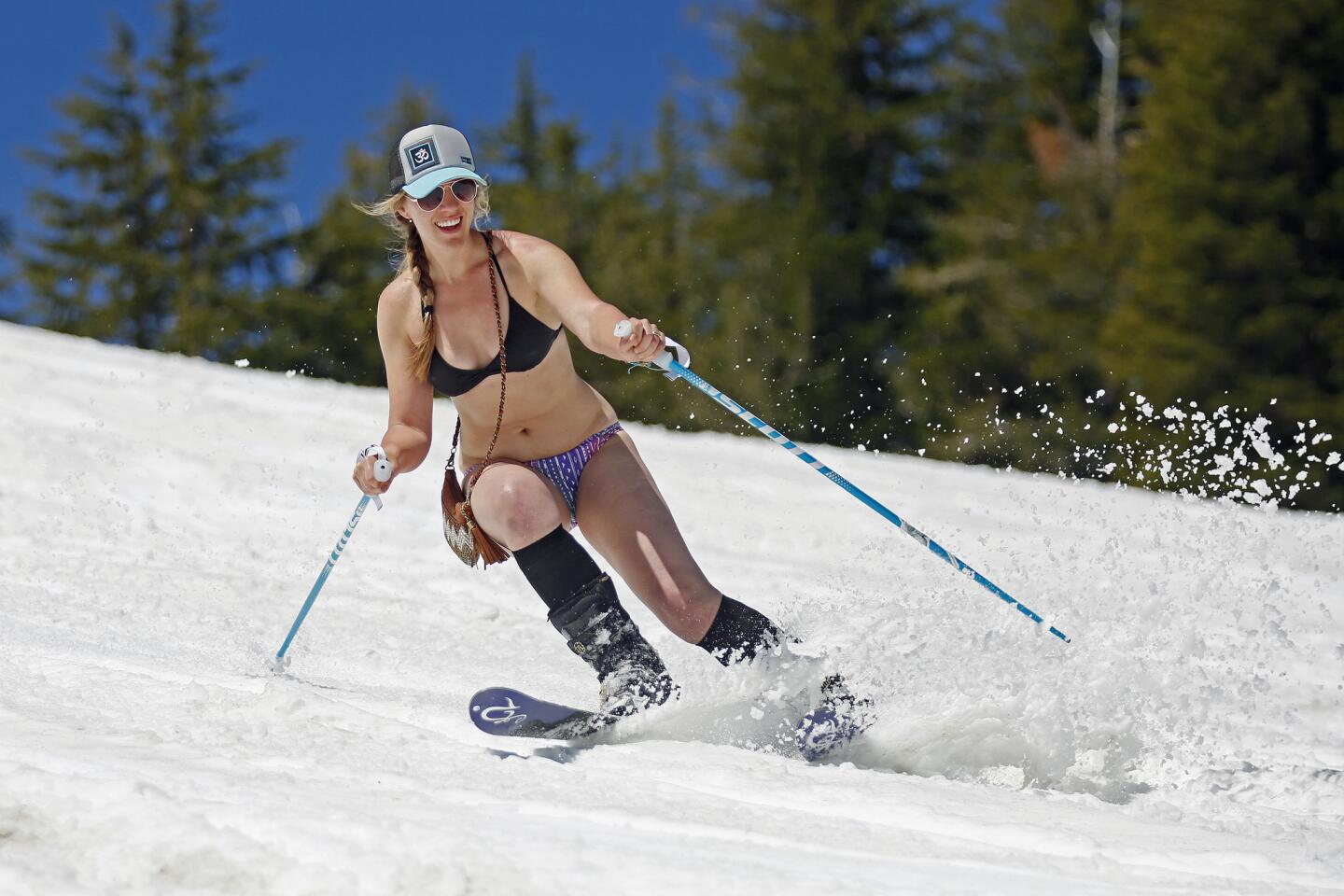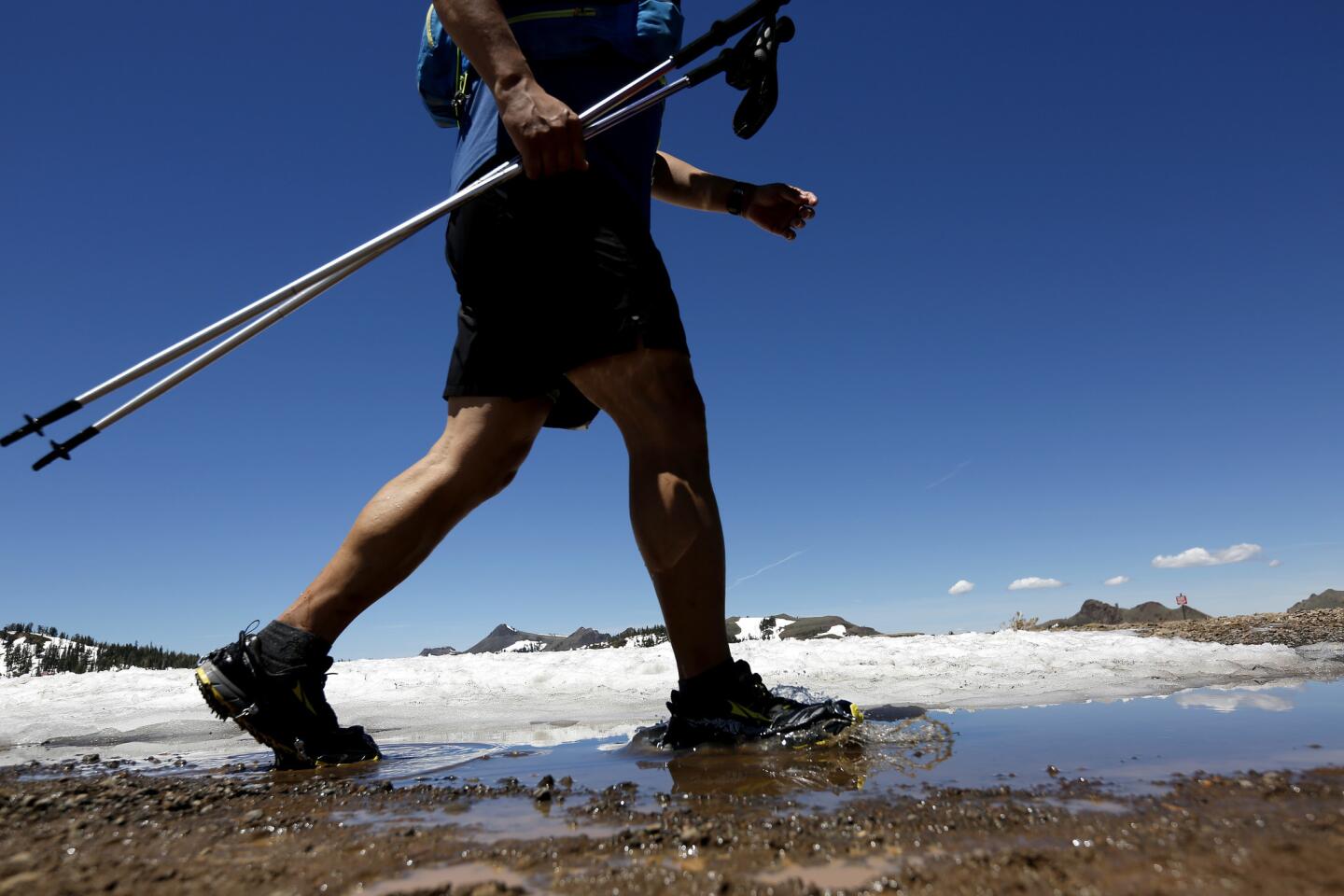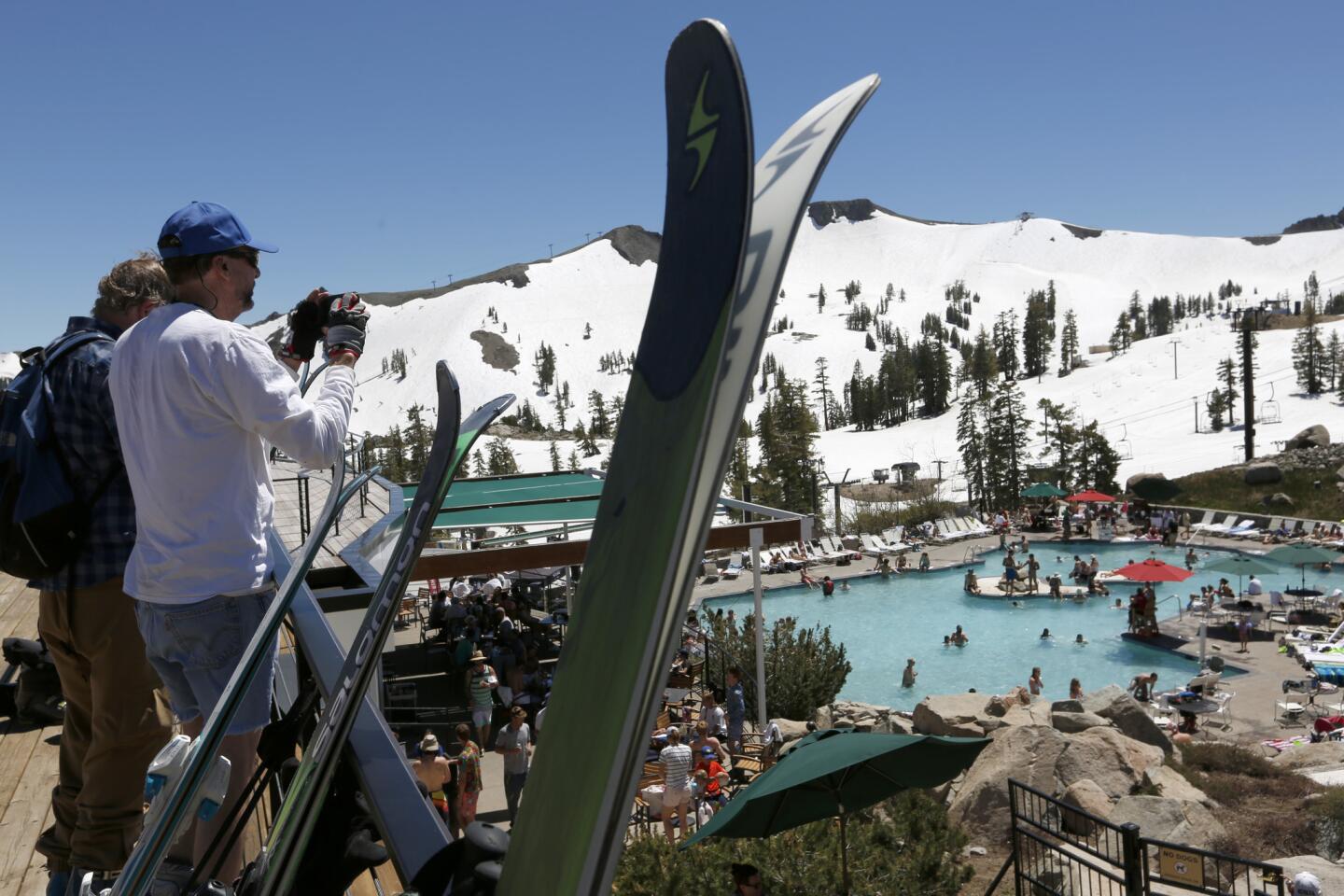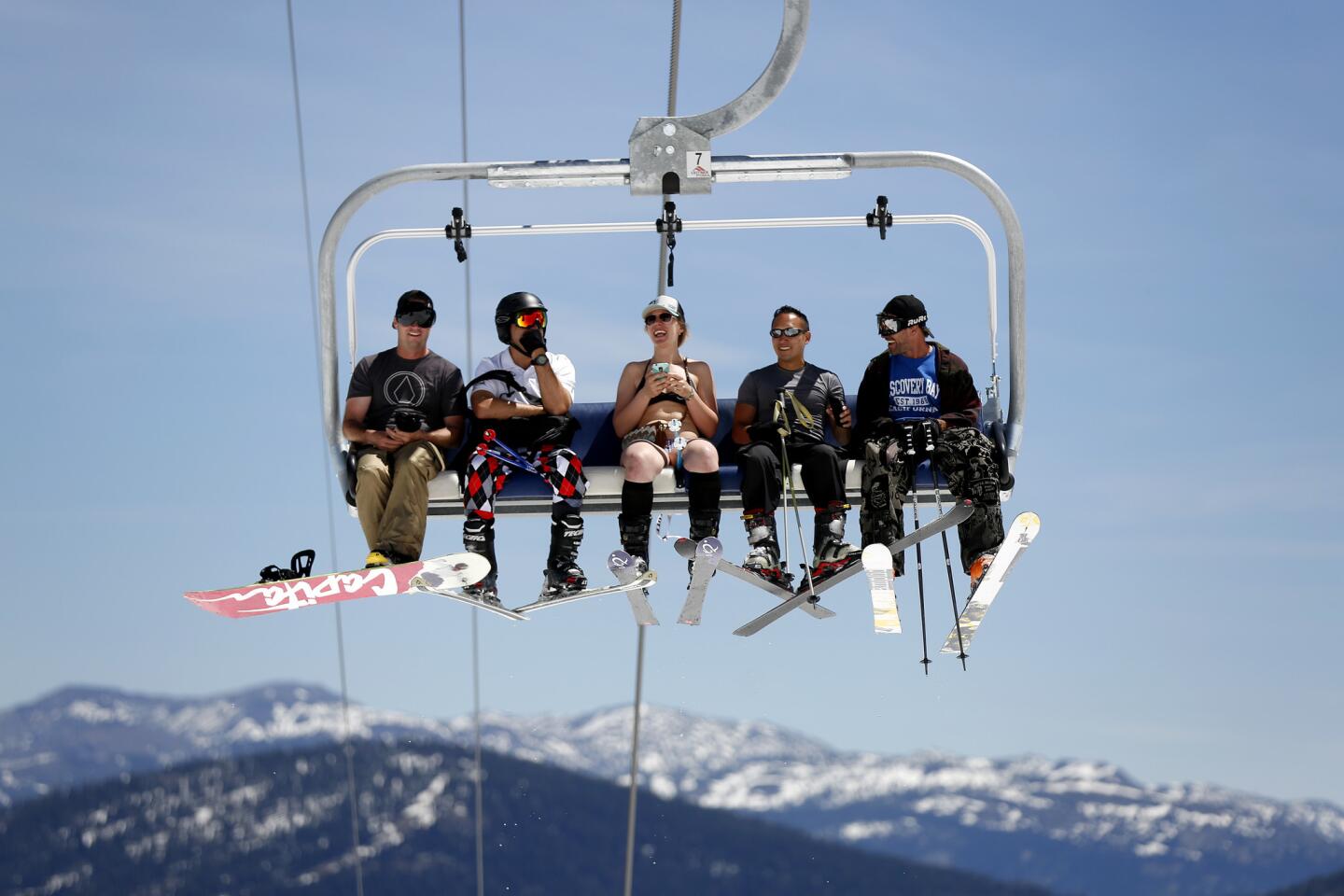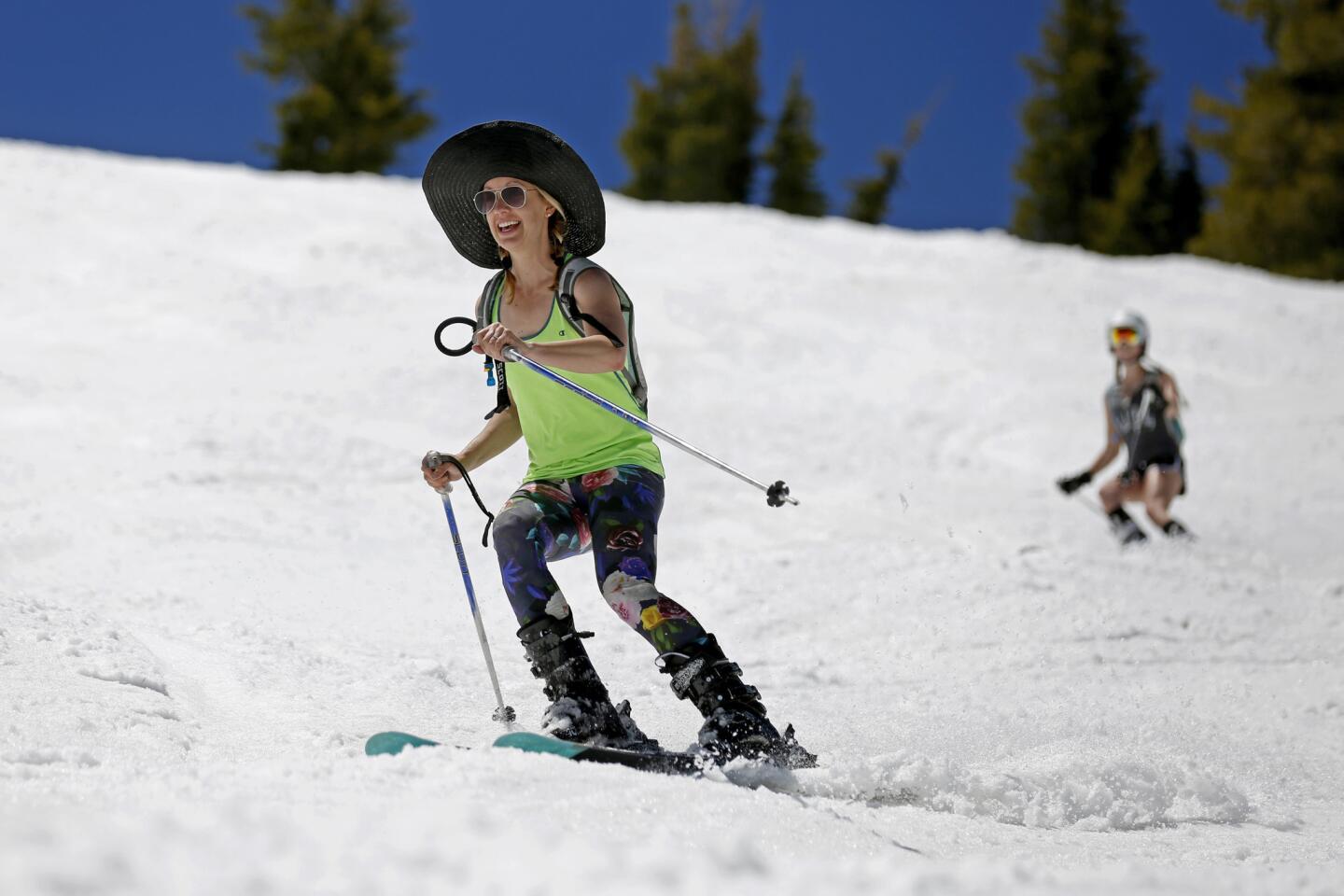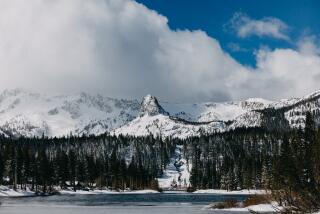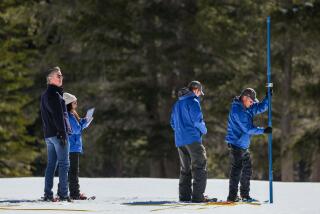Skiers hit the slopes in bikini tops as California’s endless winter endures a heat wave

Skiers hit the slopes in bikini tops as California’s endless winter endures a heat wave >> California’s endless winter: skiers in bikini tops on slopes open until August. Pacific Crest Trail hikers confronted with avalanches and snowfields that shou
- Share via
Reporting from Olympic Valley, Calif. — Skiers in bikini tops are showing up on California mountain slopes that could remain open into August. Hikers on the Pacific Crest Trail must cross miles of deep snowfields that should have melted a month ago, some of them scrambling for their lives in the icy water of raging mountain streams.
For Stev Fagran, a 56-year-old schoolteacher from Wellington, Nev., the Sierra’s endless winter gives him a chance to build on a personal record of 164 consecutive months skiing, hunting out snow patches until the flakes fall again in September.
Some years that means hunting narrow strips of snow in shaded fissures. This year, whole peaks in the Sierra Nevada remain covered.
Heat wave and snow
The seemingly contradictory weather conditions — a heat wave and mountains still piled high with snow — are one final legacy of a historic winter that brought the most rain ever recorded in Northern California.
Months of back-to-back storms finally pulled California out of its five-year drought. But they left behind up to 200 inches of snow. And it’s just beginning to melt.
Until the last few days, temperatures in the higher elevations dropped into the 20s while climbing as high as 101 on the Central Valley floor.
The slow, steady melt has filled Lake Tahoe to within inches of its brim and kept steady pressure on swollen streams, rivers and reservoirs. Signs along the American River warn visitors to stay out of the raging water, and whitewater rafters in Truckee are blocked where there is insufficient room to pass beneath bridges.
“Everyone is getting tons of water, but not when they prefer,” said National Weather Service hydrologist Tim Bardsley in Reno.
When Fagran skied Donner Summit on Monday, the mountain was capped the night before by a fresh 8 inches of snow brought by a June storm, adding to a snowpack already twice as deep as the average, and the clouds were still spitting snow. Down the road, a coyote sat undisturbed at the entrance to a Donner ski resort that had already put its lifts into summer hibernation even though the slopes were still white.
‘A quirk in the weather’
“Powder day! Or rather, chowder day!” Fagran exclaimed, downhill skis strapped to his back as he climbed a steep snow embankment on Donner Summit to join a friend waiting on the ridge. “This is a quirk in the weather. We’re going to make the most of it.”
With the Central Valley broiling in recent days, summer skiers crowded the parking lots at Olympic Village. Even with daytime highs now cresting above 70 on the mountaintops, the crews at Squaw Valley Ski Resort expect to be able to groom and tend ski runs past July 4, pushing and shoving snow around to fill in patches worn thin by the heavy traffic.
In a state where elevation, not latitude, determines the weather, Mammoth Mountain is making a run at hosting skiers deep into August, no patching required. The snow base at the mountain’s 11,000-foot summit is 200 inches deep.
Instead, said spokeswoman Lauren Burke, the resort is still clearing snow to open up wedding venues where the brides must compete with the slopes for the brightest white.
As of last week, Alpine Meadows had almost 288 inches of snow remaining.
After years of drought, the return to heavy snow has forced Californians to adopt a new lexicon for summer. “Juneary,” more commonly a Seattle word, appeared on Twitter feeds when storms dropped up to 2 feet on Lassen Summit.
Skiers seeking words to describe the crusty-in-the-morning, mushy-in-the-afternoon snow conditions turn to food. “Corn” for the granular ice balls. “Mashed potatoes” for the soft stuff. And “snow cone” for that just-right in between.
Summer skiing “is actually fun,” said Craig Gelber, 67, a retired geologist from Truckee who now moonlights at one of the local resorts. He’s hiked into the surrounding mountains — the very same ones that trapped and starved the Donner Party into cannibalism during a similar winter a century before — to find good downhill runs as late as July.
For others, the draw of summer snow is sheer novelty. In addition to skiers in bikini tops, ski patrol workers describe dealing with brutal skin abrasions on bare-skinned skiers who fall, and the lacerations and stitches needed by novices just now hitting the slopes for the first time.
Melting away
The extended snow means extended melt, and the heavy runoff has led to a bumper crop of biting buffalo gnats, residents of Sierraville complained at the village market.
The higher soil moisture is delaying the start of the wildfire season at high altitudes, but in the valleys the lush grass fed by that water has created significant fire risk for when conditions do dry out, Bardsley said.
The amount of snow remaining on the summits of California’s Sierra is “unusual but certainly not unprecedented,” Bardsley said. How unusual is largely a guess.
The longest record of snowpack measurements has been made at lower elevations that are now melted out, Bardsley said.
Those reports put the central Sierra at 195% of normal as of Saturday, one of the largest snowpacks in California’s recorded history. Deeper snow was recorded only six other times since 1950, but that was as of April, and it has snowed since.
Above 9,000 feet, the record is shorter and largely based on what satellites show from space, Bardsley said.
Those images show the dangers are great on the Pacific Crest Trail, which now draws more than 3,000 people a year to attempt the Mexico-to-Canada hike. The majority of the trail through the Sierra remains covered in deep snow, with steep snow chutes and roiling mountain streams. Through-hikers who started off in April are just now reaching snow passes that normally would have melted off a month ago.
‘It’s a big winter. It seems endless’
Jack Haskell, trail condition manager for the Friends of the Pacific Crest Trail, warns hikers to postpone their trips or be prepared to turn around.
The current hike through the Range of Light, he said, “is essentially a long-distance mountaineering endeavor.”
Online journals of some through-hikers include near-death accounts of being swept into roiling mountain streams or tumbling down snow slopes.
At the halfway point in Old Station, Bonnie Jourdan said hikers stepping off the trail to stop at her general store are carrying ice axes and snow gear, and stories of harrowing experiences. “They said it was pretty scary,” she said.
“It’s a big winter … it seems endless,” said Sam Ferrell, 37, of Truckee, attempting to keep his footing on top of snow still 5 feet deep on a segment of the Pacific Crest Trail below Donner Summit, his dog bounding ahead.
The Central Sierra Snow Lab reports the summit received 116 inches of precipitation since October — equating to 795 inches of snow at the Sugar Bowl Resort. Roads to nearby cabins remain impassable, and owners have begun trekking in to assess the winter damage from fallen trees. One found a house pushed off its foundation.
Ferrell was headed in to check that a snowboarding park had been cleaned up, also a fine excuse to cruise through fresh snow in a T-shirt.
“It is always winter, or never summer, or, whatever,” he said.
For updates and more, follow @paigestjohn.
ALSO
Scorching Southern California heat wave expected to peak Tuesday
Firefighters battle 850-acre wildfire near Big Bear
Steve Lopez: Everyone loves L.A. — and that’s the problem
More to Read
Sign up for Essential California
The most important California stories and recommendations in your inbox every morning.
You may occasionally receive promotional content from the Los Angeles Times.
